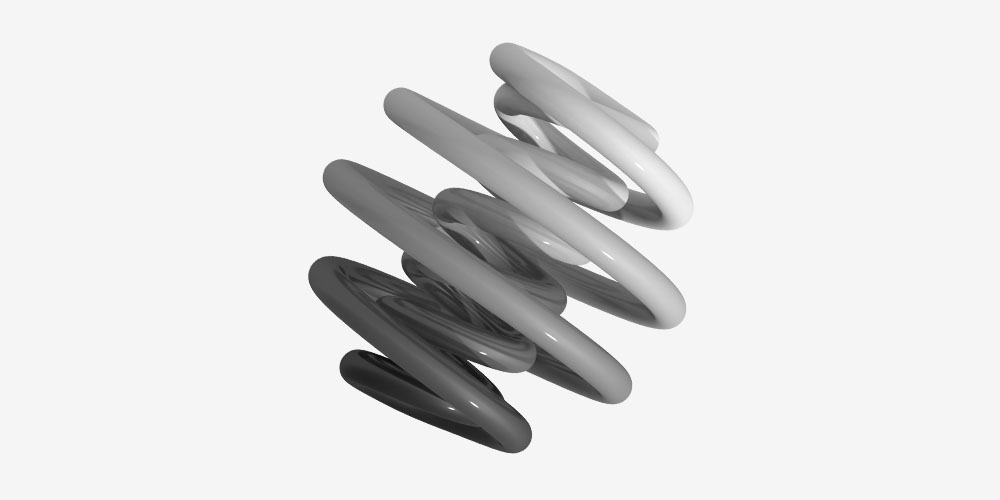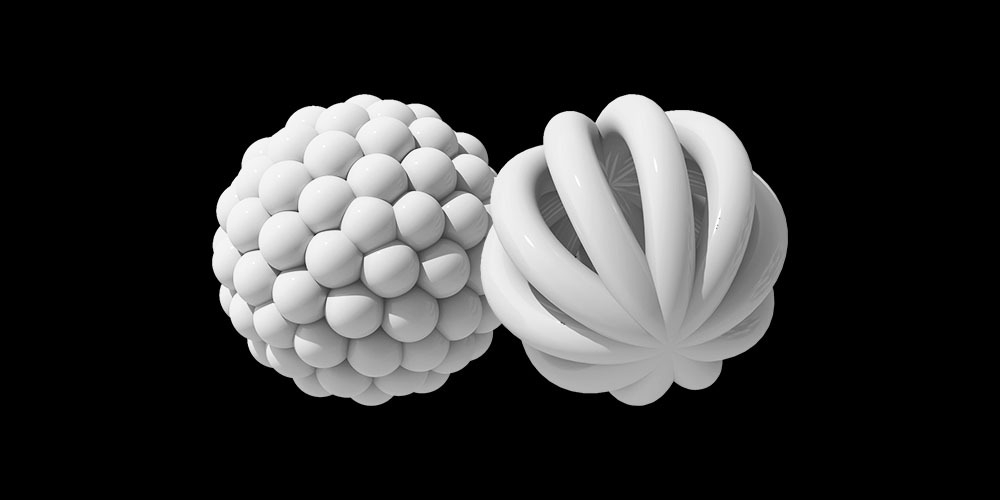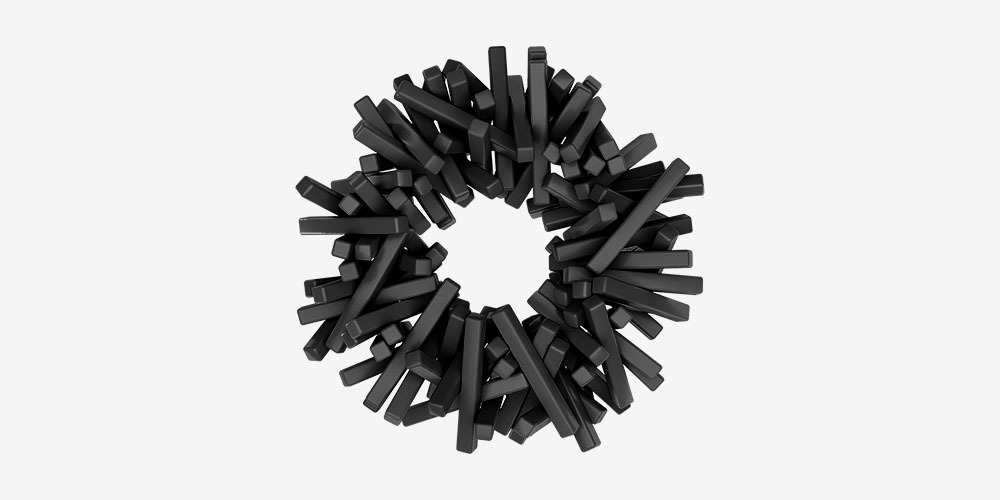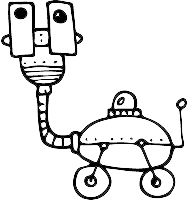Is your SaaS newsletter merely a boring duty, or can it help you bring in new customers?
Traditionally, newsletters were used either for lead nurturing or upselling. So you’d see a lot of the classic discounts and product-related promos.
But today, SaaS companies can leverage newsletters to get in front of new people, keep their community engaged, and gain loyal fans.
In this guide, we’re going over what this looks like in practice and what exact elements and structure formats you can use to impress both your current users and potential prospects through your SaaS newsletter.
Don’t wait for the muse. Apply this step-by-step method to write high-performing email campaigns in hours, not weeks.
How SaaS product newsletters are different from ecommerce ones
Let’s first understand how and why SaaS product newsletters are different from ecommerce ones.
Ecommerce emails have been around way before SaaS ones. They were used for highlighting new product launches or special offers. It’s still rare (although recommended) to see ecommerce companies go beyond this approach by tapping into building a community or educating their audience.
Similarly, SaaS newsletters started out as an attempt to notify customers about new features, updates, and other company news.
Why don’t these efforts lead to great conversion rates?
Is your product newsletter exciting?
Like thousands of SaaS companies out there, you probably have a mailing list of product users and leads. You might even be sending them occasional news.
But does your SaaS newsletter deliver what your audience wants to see? Are they looking forward to receiving your newsletter? Are they actually engaging with it?
Sadly, brief product updates and random content curation don’t get people excited.
What can you do better?
Before we jump into some hands-on examples, you need to make sure you’re setting the right goals for these emails.
Setting the right goals for your SaaS newsletter
SaaS newsletters are a long-term play. You’re using them to:
- Nurture your leads and gain their trust so in time, they will: sign up for a trial, recommend you to their peers, continue buying your tool, or switch to a higher-tier subscription.
- Educate your audience to a higher level of problem and product awareness.
- Get in front of your target market as a powerful brand and a thought leader.
- Build a sense of community (or even a real community) around your product.
- Promote special offers or discounts (e.g. Cyber Monday).
- Engage subscribers with activities beyond the actual product. (e.g. you can invite them to an event or offer to download a template).
All this takes time and continuous testing to see what your audience is more responsive to.
When setting your goals for the newsletter, think of exactly when you’d like to see results from it. Ideally, all SaaS product newsletters should focus on the long-term goal and mix in some of those special offers and conversions you can get instantly.
Newsletters as content projects vs. independent products
One more factor to consider when outlining your goals is how big you want this newsletter to be and what resources you’re willing to dedicate.
There are two options here:
- SaaS newsletter as a content project supporting your core product. This means you’d be sending them daily, weekly, twice a month, etc. In this case, you see this newsletter as an extra tool that helps you spread the word and engage with your target market.
- A standalone content newsletter with a separate mailing list. Think of big companies like Morning Brew where the product is the newsletter. In this case, the newsletter you build would get extra attention, having dedicated resources or people to really make everyone in your industry remember it. By the way, if your main goal is to grow your reach, you should always think of your SaaS newsletter as a standalone product.
Elements of a successful product newsletter
In the SaaS newsletter examples below, we’ll tap into how other successful SaaS companies are using newsletters and, specifically, what elements move the needle for them.
Below is an extensive list of these elements. You don’t need all of these in your newsletter. Select the ones that can help you reach your goals, experiment with them, or alternate them if you want to switch up your editions.
| Education | Social Engagement | Product Engagement | Emotion | |
|---|---|---|---|---|
| Tips and advice sections | Yes | — | Yes | — |
| Community or social media features highlights | Yes | Yes | — | — |
| Use cases | Yes | — | Yes | — |
| Product updates | — | — | Yes | — |
| Videos or audio content | Yes | Yes | Yes | Yes |
| Events, webinars, and feature announcements | Yes | Yes | Yes | Yes |
| Curated industry news | Yes | Yes | — | Yes |
| Unique articles you’re not posting elsewhere | Yes | — | Yes | — |
| Templates and other downloadable resources | Yes | Yes | Yes | — |
| Special offers and discounts | — | — | Yes | — |
| Causes or organizations you’re supporting | — | Yes | — | Yes |
| Product tips and how-to snippets | Yes | — | Yes | — |
| Recently posted articles | Yes | — | Yes | — |
| Your newsletter in an audio format | Yes | — | Yes | — |
| Team updates or content your team’s discovered | Yes | Yes | — | Yes |
| Jokes and fun facts | Yes | Yes | — | Yes |
| Contests and challenges | Yes | Yes | Yes | Yes |
| Q&A sections | Yes | Yes | Yes | — |
| Client projects, stories, and achievements | Yes | Yes | Yes | Yes |
| New partnerships | — | Yes | Yes | — |
| Jobs and help requests | Yes | Yes | — | — |
Now, how you share all these matters the most.
Let’s see how other SaaS companies go about building newsletters that stand out.
Our collection of SaaS newsletter examples for your inspiration
#1. Organize sections in an order your readers will want to see: Postmark

Postmark is an “email delivery service that people actually like.” With this goal, it’s only natural for their newsletter to deliver upon this promise as well. Their editions are a classic curation of recent posts and events from their own blog.
But, they’re not just listed randomly. They start from the topics everyone would be interested in. In this case: “Transactional vs. marketing email: What’s the difference?” and “Transactional and marketing email: how to use them together”. They leave product-heavy posts and updates for the end of the article alongside a fun section.
Postmark’s newsletter formula:
- Educational article
- Case study feature (but notice how the focus is on the results, not the tool)
- Article to share some more tips
- Product-focused article
- Fun section for sharing focus music for remote teams
#2. Opt for a classic one-on-one email: Help Scout
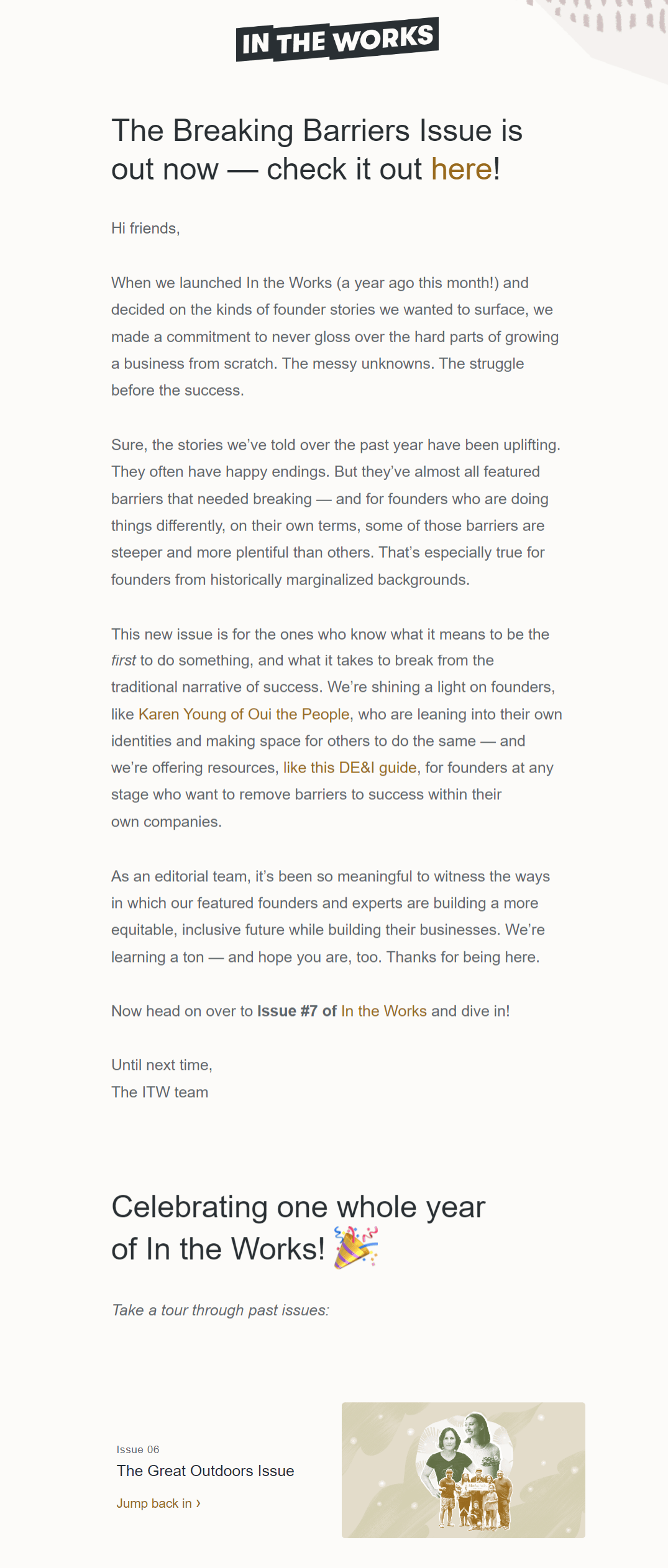
Help Scout is a help desk software designed to make it easier for you to manage customer communications. And they set the standards for sending newsletters as well. Their “In the Works” newsletter is built to resemble a personal email as opposed to just listing everything straightway. To view the actual content, you need to click on a link within the newsletter’s heading which redirects you to their online magazine.
The benefit of this strategy? You can highlight the important things you want to share in this one-on-one email. That’s it. No distractions. No feeling tempted to quickly scroll through the newsletter.
On top of this, they do something no other SaaS company does in their newsletters. They make it easy for readers to check out the previous editions too, in case they missed it.
Help Scout’s newsletter formula:
- Personal direct message which leads to the full newsletter edition
- Highlight of past editions
#3. Align your content with events or trends: Todoist
Thanks to Katarina Andrejevic of Opascope for this example.
Subject: Try these anti-stress Todoist workflows

Readers are more likely to engage with your newsletter if you write about what’s already on their minds like events, holidays, or trends.
Todoist, a task management platform, demonstrated this perfectly. But instead of talking about productivity, they focused on reducing stress and work-life balance during Mental Health Awareness Month.
Todoist’s newsletter formula:
- Intro: Quick rundown of the issue
- Second section: Stress self assessment
- Third section: How to reduce daily stress
- Fourth section: How to lead teams with wellbeing in mind
- Fifth section: Customer story
#4. Show, not just tell: Clay
Subject: 👀 Discover What’s New: Clay’s Summer Roundup!

Visual elements can do many things for your newsletter – from breaking walls of text to showcasing your latest feature in action. That’s why it’s better to show instead of just tell.
For a summer edition of their newsletter, Clay used GIFs to show their latest feature updates in action. Here’s the GIF that showcased their workbooks feature:
They also used other visual elements to talk about their new integrations, their latest community events, and to promote their blog.
Clay’s newsletter formula:
- Feature updates
- Integrations
- Community updates
- Promotion of their blog
#5. Provide an industry digest: Wealthsimple

A lot of the newsletters you’re receiving right now are based on the curation idea. That’s because people simply like to consume a lot of information in a simpler, more digestible format. Wealthsimple is an example of doing this perfectly.
Why? They take each piece of news and summarize it so you won’t need to go to the original article to get the main points and how they’ll impact you.
Wealthsimple is an online investment management service so users can only trust their product if the content they deliver is also accurate. On top of this, they format news using fun elements like the FOMO index above, making everything easier to skim.
Wealthsimple’s newsletter formula:
- Summary of topics covered in the issue
- Last week’s news
- News highlighted in an eye-catching format
- Things happening this week
- Industries to watch
- Other good reads
- Twitter highlights
#6. Stay away from the product, but close to the use case: SparkToro
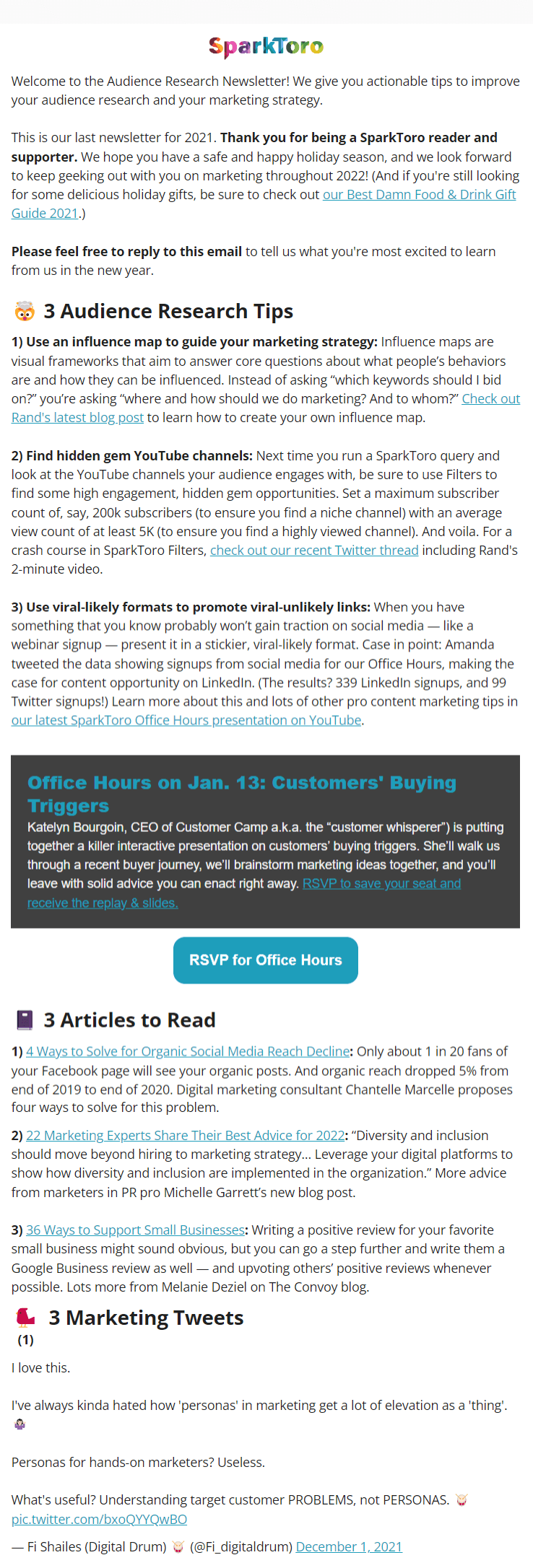
SparkToro is an audience research tool by Rand Fishkin. In their newsletter, they opt for an email structure that gives out tips, news, and tweets on their industry. Their product does audience research, so that’s what they talk about — without having to make it all about their product.
The SparkToro format is an easy starting point for your first SaaS newsletter.
SparkToro’s newsletter formula:
- Introduction
- 2-3 actionable tips
- Optional event announcement
- 2-3 news and their summary
- 2-3 highlights from your community/social media
#7. Share a balanced mix of handy tips and product: Balsamiq
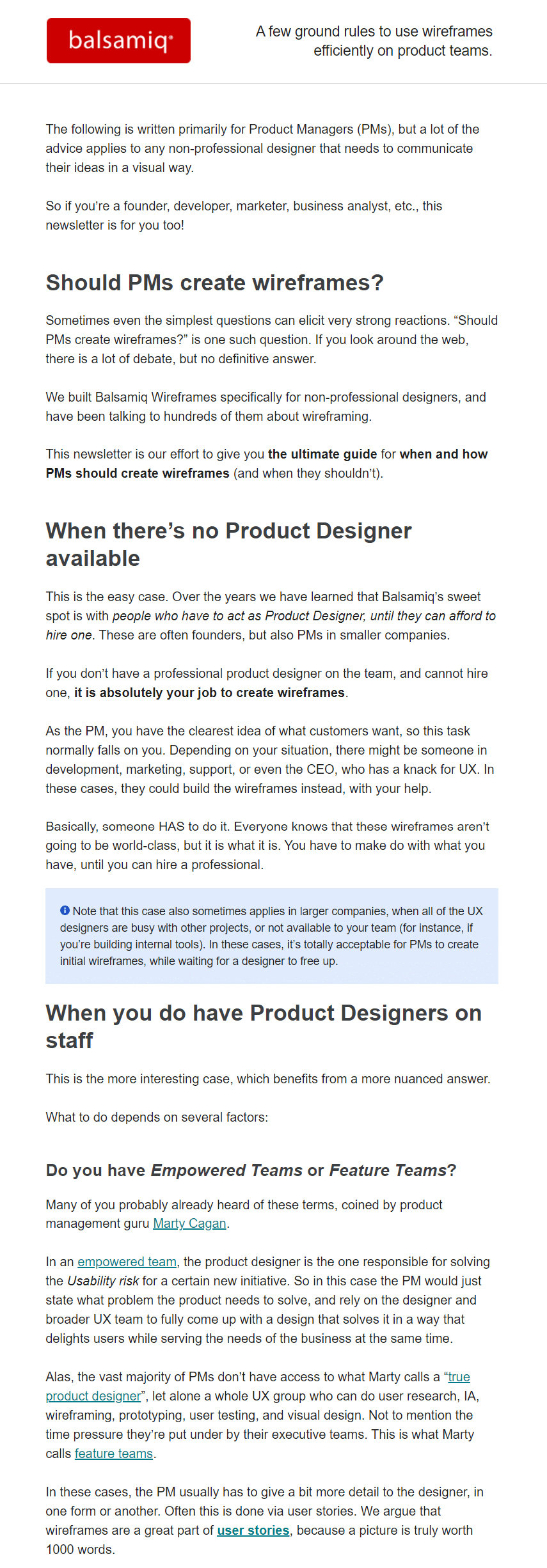
If you’ve got “so much to share”, a long-format newsletter is always fine, given you have the right format. Balsamiq — a popular wireframing tool — has dedicated themes for each of its newsletter editions. They start off by tackling that topic extensively through an article-like post. While this covers more than 70% of the newsletter, you’ll still find sections like Happy customer of the month, Product news, and Company news.
This structure ensures there’s something for everyone. Current users can look through the article and check out some of the product news while leads will get the social proof from the testimonial as an extra.
You can read their full newsletter here.
Balsamiq’s newsletter formula:
- A core topic tackled extensively
- Happy customer of the month feature
- Product news
- Wireframing Academy news
- Company news
Don’t wait for the muse. Apply this step-by-step method to write high-performing email campaigns in hours, not weeks.
#8. Share templates & in-product resources: CoSchedule

Another way to provide a good reason to always open that email for both customers and leads is to give out something for free. This “something” can be a template, a free ebook, or anything they can download straight away.
CoSchedule — an organization tool for marketers — is brilliant at this as they pair new articles and industry updates with templates and other downloadable materials. The best part? These templates can only be used in CoSchedule. So while current users will find it super quick to just use these, prospects will get in front of the tool and maybe even take it for a spin.
CoSchedule’s newsletter formula:
- Post feature for one topic
- Another post feature for a different topic
- One more blog post
- Articles from around the web
- Mini-ad for a free tool
#9. Keep things different every now and then: Canva
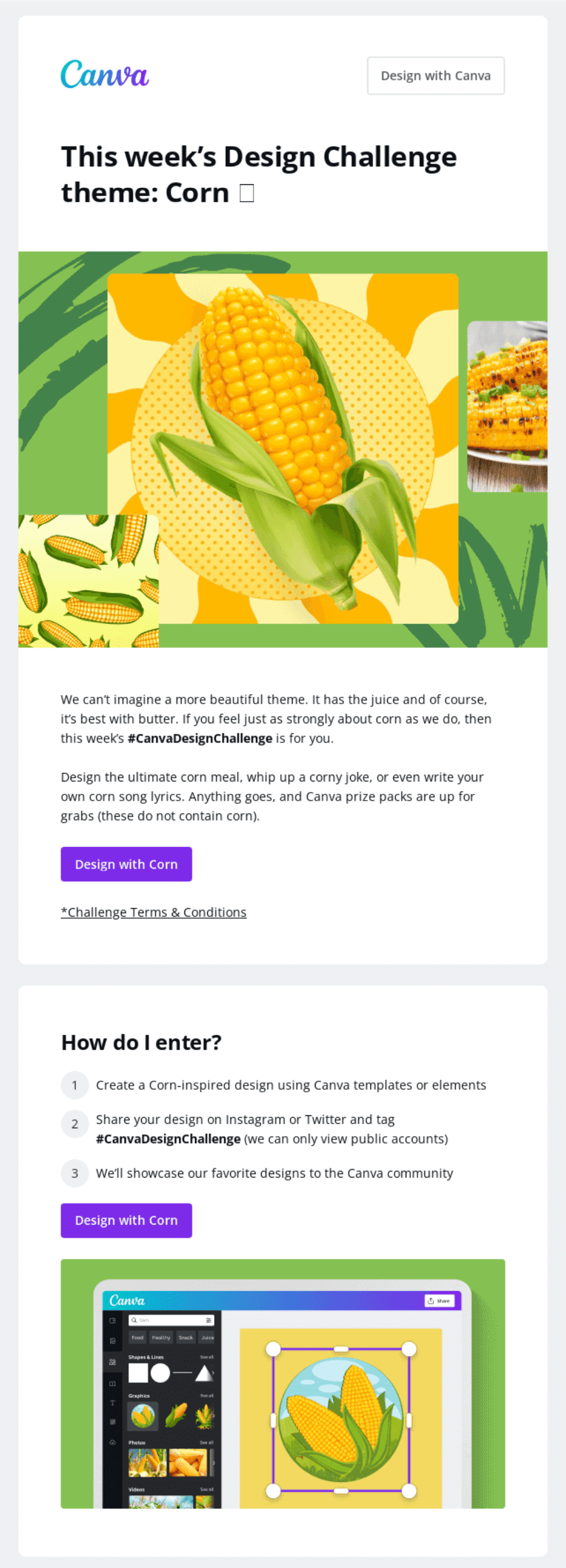
The general recommendation is to keep editions consistent. But what if things don’t convert the way you want them to? Or what if you just want a lot of emphasis on a specific event or feature you’ve got coming up?
That’s when it’s perfectly fine to either change up the newsletter’s sections or just focus on one thing for that specific edition like Canva does in this example by promoting a design challenge. Bonus points if you can get people to use your tool for this (as Canva did).
Canva’s newsletter formula:
- Switch it up by alternating topics
- Feature inspiration from your own users
#10. Tailor every section to a different goal: Clearbit

There’s only so much time people can dedicate to reading your newsletter. So make it worth it by having a specific goal for each section.
Let’s see how Clearbit, a B2B marketing intelligence platform, nails this by understanding each section and its goal.
Clearbit’s newsletter formula:
- Trivia → Fun intro
- Initial section → Get your audience in front of your content
- Second section → Highlight a product/company achievement
- Third section → Share webinar replay to showcase your product
- Fourth section → Share new awards to build trust
- Fifth section → Book club announcement to build community
#11. Involve your community: Stack Overflow
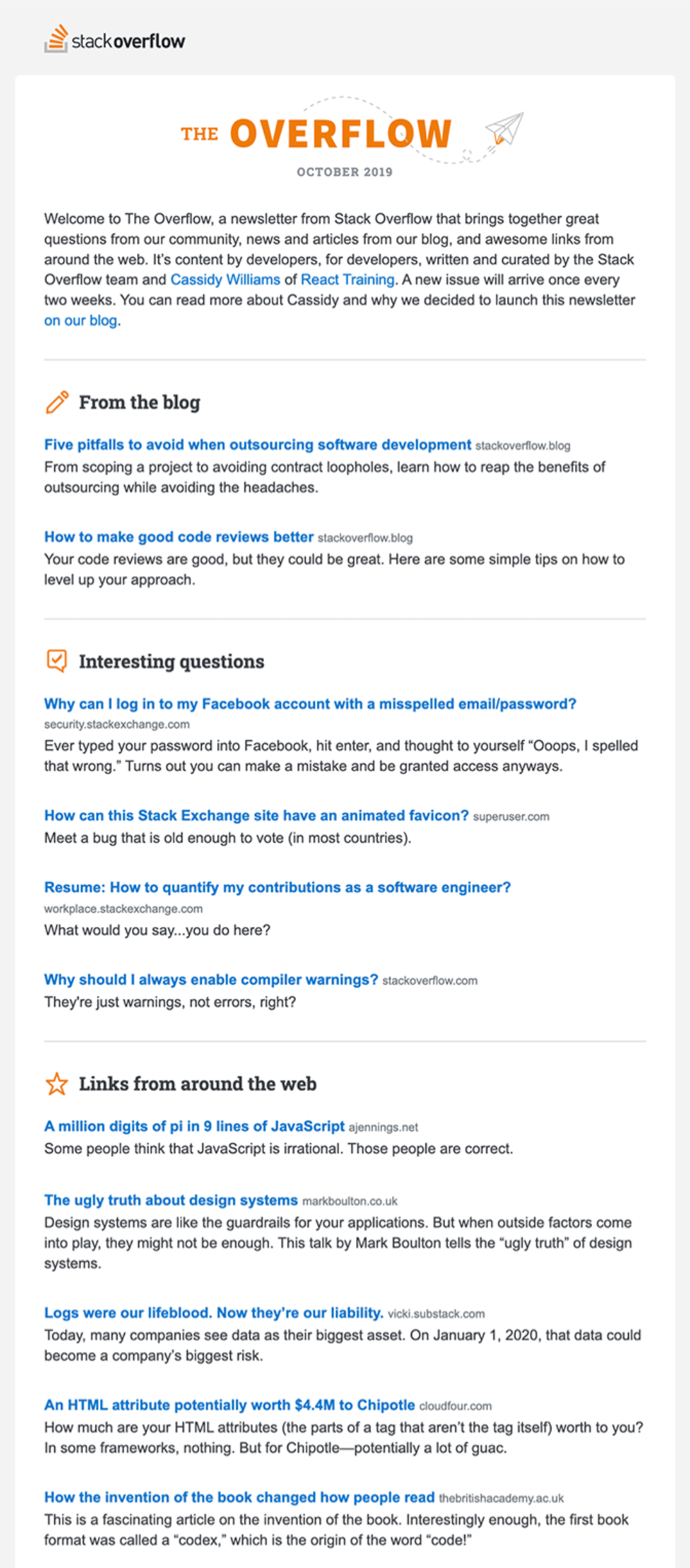
Got a Facebook group? Slack community? Or just users asking you a lot of questions?
Highlight those discussions in your next newsletter. Stack Overflow does this by having a dedicated section for interesting questions they get in their community. This is a handy addition that lets you grow your community while also making sure you’re helping current members get the answers they need. A win on both ends! Plus, the tool itself is built as a knowledge sharing tool for devs, so they have loads of insights they can access.
Stack Overflow’s newsletter formula:
- Blog highlights
- Interesting questions from their own public community
- Links from the web
#12. Product-led newsletters? We’re in: Headspace

When your product allows you to connect your content to the actual functionalities you offer, sharing educational resources while also keeping the product at the forefront is extra easy.
In the Headspace newsletter, they stick to a brief newsletter where all the highlights are content pieces you can consume within their own meditation and sleep app.
Need more ideas? Other brands are nailing product-led content. Figma lets you remix assets their users are building while Phantombuster and Zapier share automation sequences you can use instantly.
Headspaces’s newsletter formula:
- Expert advice section
- Quick mental exercise
- Music spotlight
- One more highlight of another tool they have
#13. Always listen to what your audience wants: Tella

Tella, a Loom competitor, has been sharing strictly a product update newsletter with tips on how to use any new features. And their users love it. Once you’ve built a great product and are able to listen to what users truly want, even marketing emails seem easier to build. So when in doubt, just ask them!
This strategy works wonders at an early stage when you don’t have dedicated marketing resources yet. But when your audience wants it, the stage you’re at doesn’t even matter. Typeform, for instance, sticks to a format that’s primarily focused on its product and users.
Tella’s newsletter formula:
- Introduce your updates
- Add in secondary news and updates
- Optional: Article or case study from your blog
#14. Skip on the newsletter and send a report instead: Grammarly
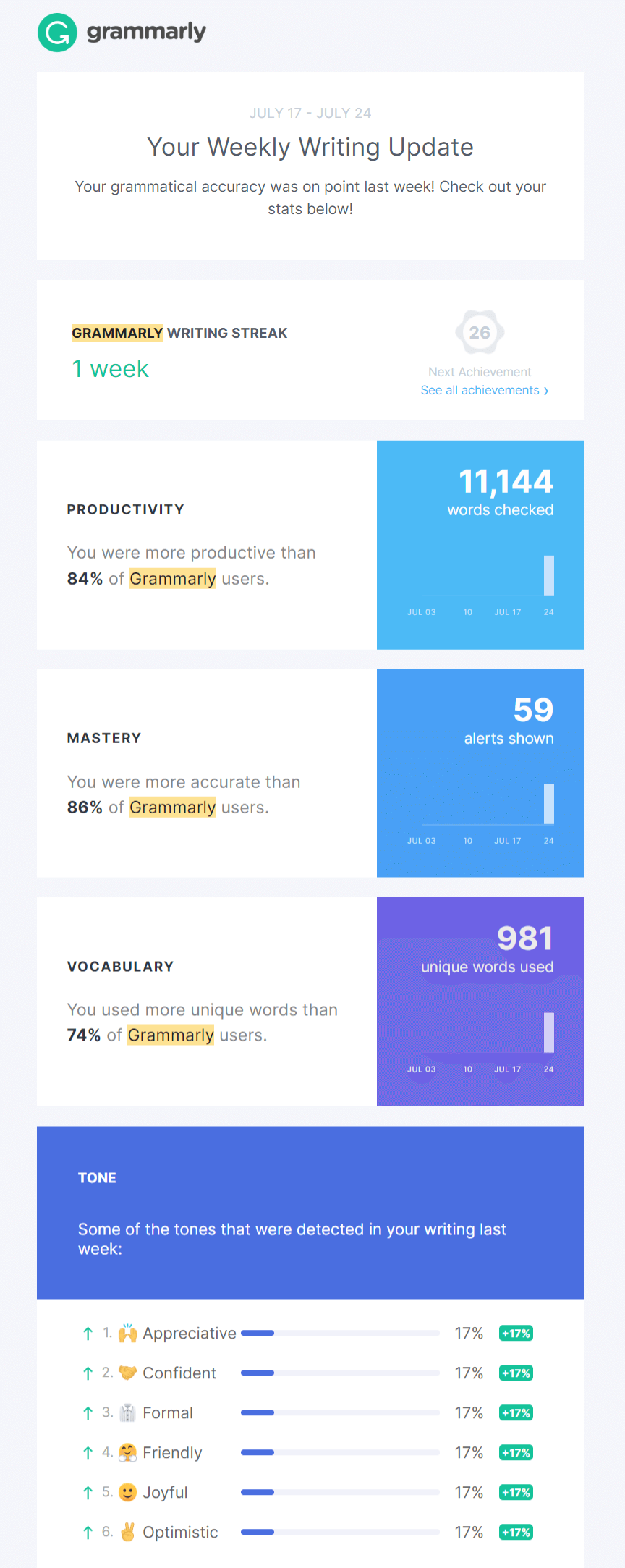
This example from Grammarly, a cloud-based typing assistant, gives us a perfect look at how you don’t need a traditional format to stand out. Note that this isn’t their official newsletter but a regular email they send to their users and also the email they’ll remember the most.This email provides exactly the type of insights subscribers need while also keeping the product at the center of everything.
Their regular writing stats use data that Grammarly owns in a gamified format that gets people excited to always check on their email and see their progress. You even get to see which handy features you’re not using yet, complete with a product offer/discount to switch up your writing game.
Execution tips for a SaaS newsletter people won’t skip
This might seem like a lot, but we’ve prepared a quick step-by-step process to help you finally hit send on that newsletter and reap the rewards:
- Establish a framework/format. Using the “one goal per section” method, build an outline for your newsletter. Remember, you can always move these around or replace them if people don’t engage with a specific section.
- Leave space for experiments/variation. If you opt for a format like what Clearbit or SparkToro did, changing sections and A/B testing them gets easier. When you’re just getting started, don’t set too many expectations. If people get used to receiving things they don’t crave (e.g. dry product updates) they won’t open your future newsletters even when you switch their format because they just won’t know you did it.
- Decide how often you want to send your newsletter. Again, there’s always room to experiment here. The whole point is to stick to a regular schedule so people will know when to expect the email. Monthly is a good place to start. Or, you can let subscribers decide like GitHub does.
- Collect materials throughout the month. To avoid running out of content, keep an eye on updates and interesting links or discussions throughout the whole month. Add them to a swipe file document, and refer to it whenever it’s time to write the newsletter to speed things up.
- Have fun! Rigid emails are a big no. Add in fun content, let your team take over the newsletter every now and then, or hand the mic to a loyal user you want to highlight.
- Segment your audience. Yes, you can send different newsletters to separate subscriber segments. Or you might want to create variations of the same newsletter. Your current users can receive one that’s a bit more focused on the product. Meanwhile, for lead nurturing, you’ll want to focus on building trust and highlighting educational resources or case studies, as opposed to new updates.
- Skip on the newsletter during certain lifecycle stages. We recommend having a “Qualified for Updates” segment that excludes users who are currently being onboarded as leads or trials. Similarly, if you’ve got a drip campaign you want your list to focus on, you might want to skip the newsletter for them during that time frame.
What should go into your next newsletter edition?
Use our recommendations above to put together your SaaS newsletter structure. Start collecting resources and creating unique content to share with your audience — whether they’re current users or prospects.
Regardless of your goals, you want your newsletter to stand out in your industry. Once subscribers start remembering your editions and positioning your company as a leader in the field, they’ll also recommend it to their colleagues and friends.
In fact, you can even add in a call-to-action to ask happy subscribers to share the newsletter with their network. You definitely want to keep your current audience happy with the content, but always remember you need to grow and expand your list to reach new heights.
And remember:
- Don’t make it too long
- Use visuals whenever possible
- Always listen to what readers want to see!
Don’t miss out on new articles. Subscribe to our newsletter and get your monthly dose of SaaS email marketing insights.


